For the past eight years, the Stone Fabricator’s Alliance (SFA) takes a group of fabricators from North America, many of which have never traveled once outside the country, and brings them to Italy to learn about machinery, tooling and different types of stone. The trip is hosted by Tenax, and I have personally been fortunate enough to be invited to join the group for the past three years — each time being 10 days long and packed with education. It’s amazing what someone can learn just once, let alone three times. Now for a quick disclaimer, I have never hand polished a countertop, never operated a CNC machine or had to deal with an angry customer. But from spending about a month’s worth of my life on a bus full of some of the most skilled fabricators in the industry, I think I could pick up any tool and get by. OK, this is probably not true, but I at least know the general idea.
The first time I was a part of the SFA trip, I was under the assumption that the main reason people went on it was to learn more about the machines they buy from Italy, to see where Carrara marble comes from or how CNC tooling is made. Some of this may be true, and it definitely is a draw, but one of the biggest things people learn about is how to transform their shop. How to make their shop stand out compared to the competition. Most fabricators generally don’t want to compete on the lowest prices, but want to create an atmosphere and a service that no one else in their market can touch. Last year, while out with a few of the fabricators on the last night, one said, “I am going to do what the Italians do. I am going to have my sales people dress up in suits and serve Prosecco to my guests.” Now while he said that in jest, there was some truth to it, and it’s the unexpected thing that I have realized many of the fabricators take away from the experience and apply to their business — the service and atmosphere of the Italian culture.
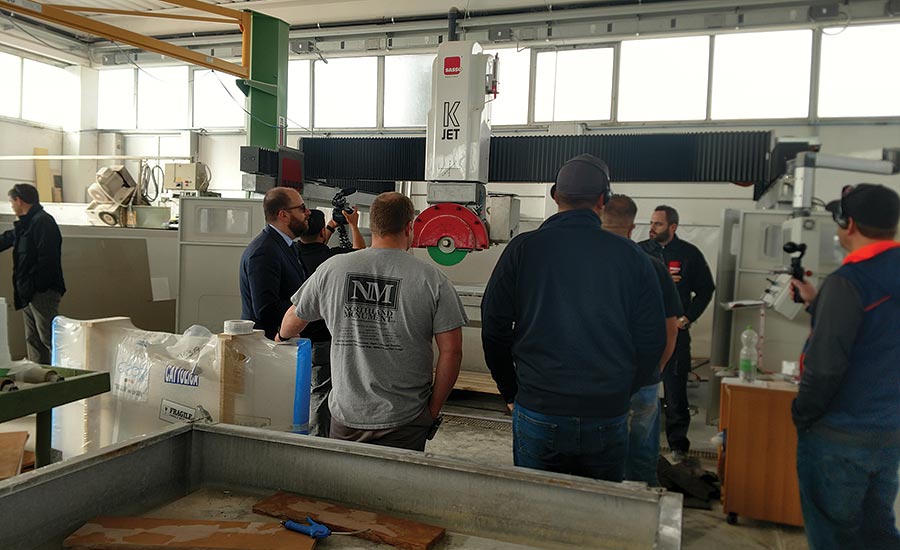
Now before I get into people’s personal experiences and how they have changed their business and observations that I have made, in case you have never heard of the trip, here is a rundown of this year’s excursion to give you an idea.
The first half
This year’s trip started in Rome, Italy, where the group spent two nights and a day touring the city. Having the opportunity to see how ancient Romans used stone in their architecture and coming up with sayings such as, “If that seam is good enough for the Pantheon in Rome, it’s good enough for your kitchen, Mrs. Smith.” For many of the fabricators, it was their first time eating authentic Italian food and drinking Italian wine – in many cases right at the vineyard. For some fabricators like TJ Henderson of MC Tops, it was one of the highlights of the trip. “The first full day in Rome, myself and some others on the trip had lunch at Fres & Co.,” said Henderson. “It was a two- to three-hour lunch, and it was nice to just relax and get to know some of the others on the trip.”
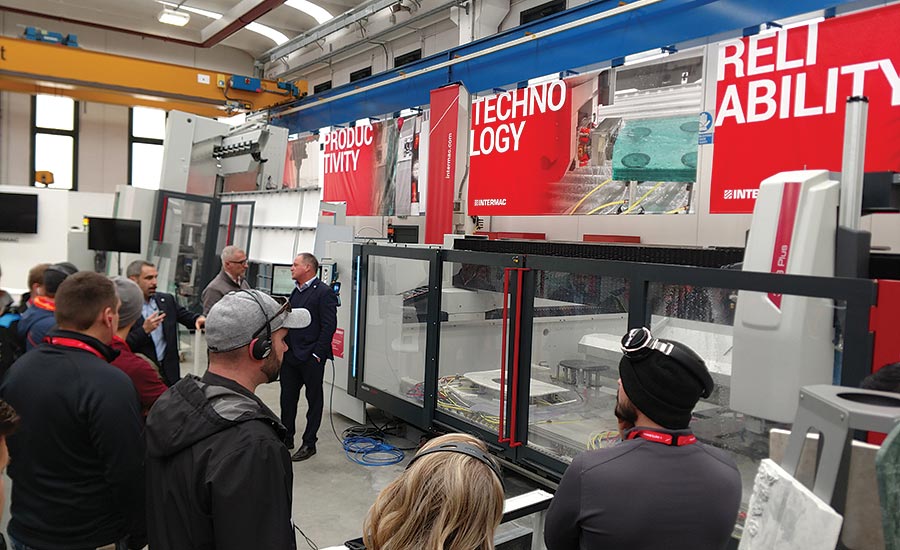
The first day of the actual tour began with a short bus ride to Sasso Meccanica where the group met Mario Caroselli Leali, who gave the group a tour of the facility. “For us, the most important thing about our machines is the accuracy,” said Leali. “If it’s not accurate, it’s not good. It’s why we use a rack and pinion system.” Leali continued to show the group the process of making different Sasso machines before taking them to a marble shop in Italy where the new K Jet CNC saw was in operation. The group also was the first to see the newest version of the Flying Flat machine that will be coming out in the near future. “We really enjoy working with the SFA and want to do it more,” said Leali. “It’s great that you guys are willing to help the new people in the industry. You should be very proud of that. It does not happen that often.”
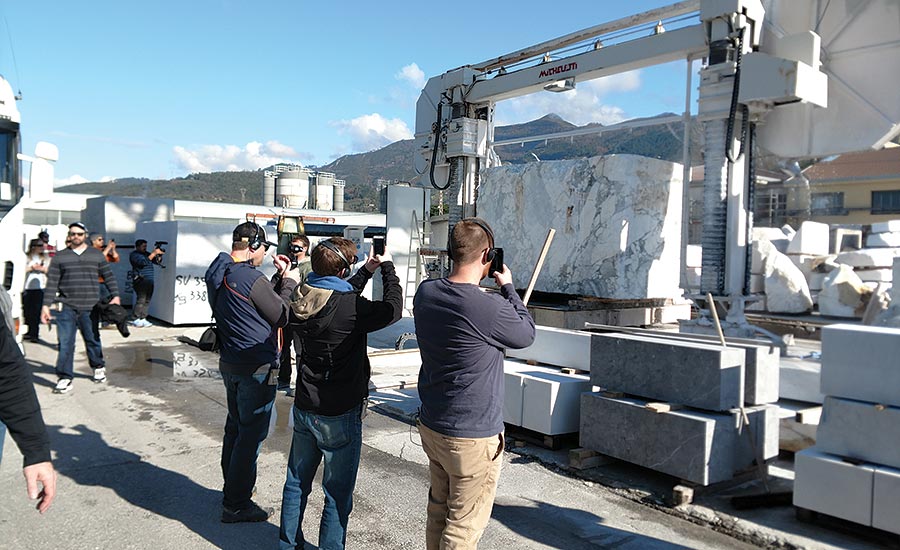
The group then hopped back on the bus to head to Intermac to see its production facility, academy and Internet of Things (IoT) platform. The group was led by Michele Ragno of Intermac and the Biesse Group of Italy. The group got to watch the production of the machines, as well as demonstrations of how the machines operated. While the group watched the machines in action, I had the opportunity to sit down with Franco Angelotti, the division manager for Intermac. “Intermac has been in the stone industry for a long time and our focus has been to be a global player; that’s why we have the Donatoni partnership and why we purchased Montresor,” said Angelott. “The feedback from the market is extremely positive because we can give top-quality machines. We also see ceramic becoming very popular, but natural stone won’t disappear. Our job though is to give solutions for all your cutting needs. If it is natural stone, ceramic or other materials, that’s what we are here for. It’s also why we pride ourselves on customer service and renewed our website to make it easier to work with. And finally, it’s why we are offering our academy education center to help fabricators learn more.”
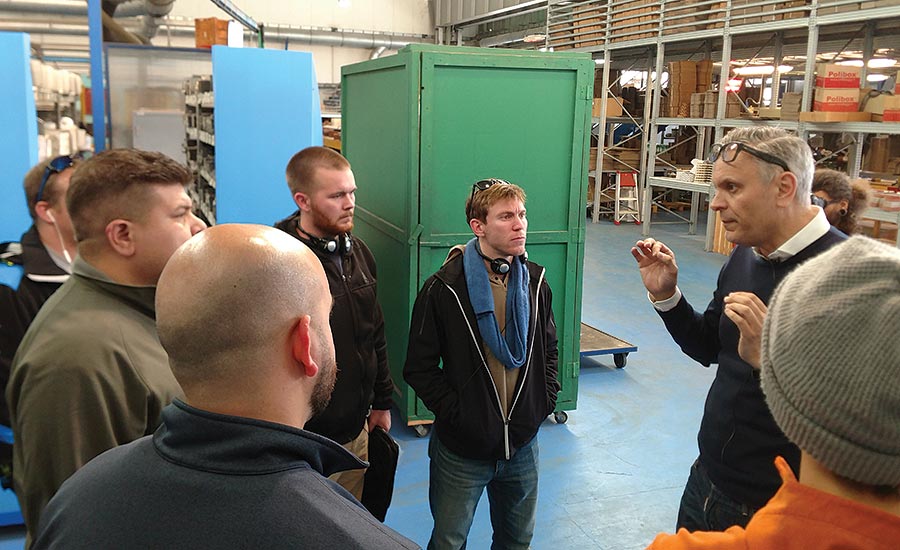
One of the new features Intermac introduced was “Sophia.” It is Biesse’s IoT platform that enables customers to access an extensive range of services to streamline and rationalize their work management process. It allows the ability to send real-time information and data on the technologies in use, optimizing the performance and productivity of machines and systems. It consists of the IoT side and the parts side.
The second day of the trip started with a transfer to the Henraux Quarry to see where Carrara marble is produced. It’s always a highlight of the trip, and something that truly wows fabricators to see. “I think seeing the quarries was one of the best parts,” said Fabio Figueiredo, president of La Pietra Marble. “It was probably the first marble quarry I had been to as well, but the classic marble had so much history behind it. It was so great to see it in person. It was great to meet the guys there who quarry this material and see what there life was like. It was a whole new perspective on something I have been doing since I was 20; and to see that quarry, it was awesome.”
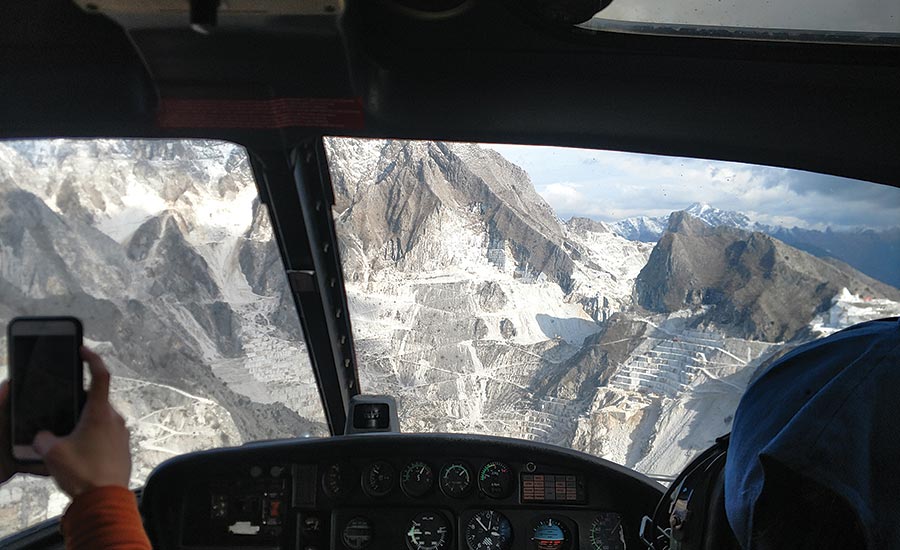
For Henderson, it was one of the things he looked forward to on the trip the most. “I had an idea of what it would be like, but seeing it first-hand just blew me away,” he said. “The size, the random carvings on the blocks throughout from the workers, hearing the stories from the guys who had worked there for years. It was something special.”
The next stop on the tour was at Nicolai Diamant, where the group was met by Miller Ganapini. Ganapini walked us through the facility to show how Nicolai’s CNC tooling is made. He also spent time explaining the Nicolai Diamant Academy. “We have a training facility in Grand Rapids, MI,” said Ganapini. “It features state-of-the-art machines such as a CMS Brembana CNC machine, a Montresor edge polisher and a GMM bridge saw. If you want to cross train your employees, you could train your bridge saw guy on our CNC machine. We do it free of charge.” The group also got to see how Nicolai Diamant uses the Zares II machine to check for accuracy in their tools and also on their EDM machine. They also offer a service for fabricators to use the Zares II to check their tools to make sure they are only taking off minimal amounts of the tool so it helps preserve the life of the tool. “I liked seeing how each tooth was soldered onto the tooling at Nicolai,” said Jeannie Fung-Donaire of JF Tile and Stone Studio. “I didn’t know they were all done by hand. Very appreciative to see the factory in motion and meeting the people that worked at these factories.”
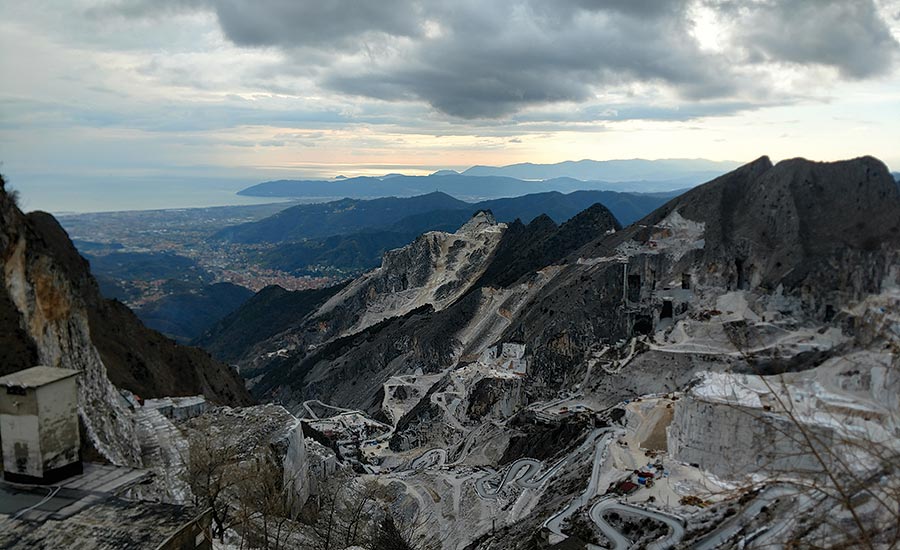
Before the end of the day there was one more experience Ganapini and Nicolai Diamant had for the group. If you talk to anyone on that trip, they will probably all agree; it was one of, if not the best, experience of the trip. That was taking a helicopter tour from the sea to the quarries — showing off the Alpi Apuane Mountains and the Carrara marble quarries. Each helicopter ride brought up five people, on five separate flights, to land in one of the Carrara quarries, a Statuario marble quarry, quarried by the Franchi group. “The helicopter tour of the Carrara quarry that Miller at Nicoai organized was second to none,” said Henderson. “The amount of work that went into organizing that 15-minute tour was pretty cool to hear.”
“I’ll probably be with the majority here and say the helicopter ride over the quarry was the most memorable part of the trip,” said Rey Rodriguez of Ageless Stoneworks Inc.
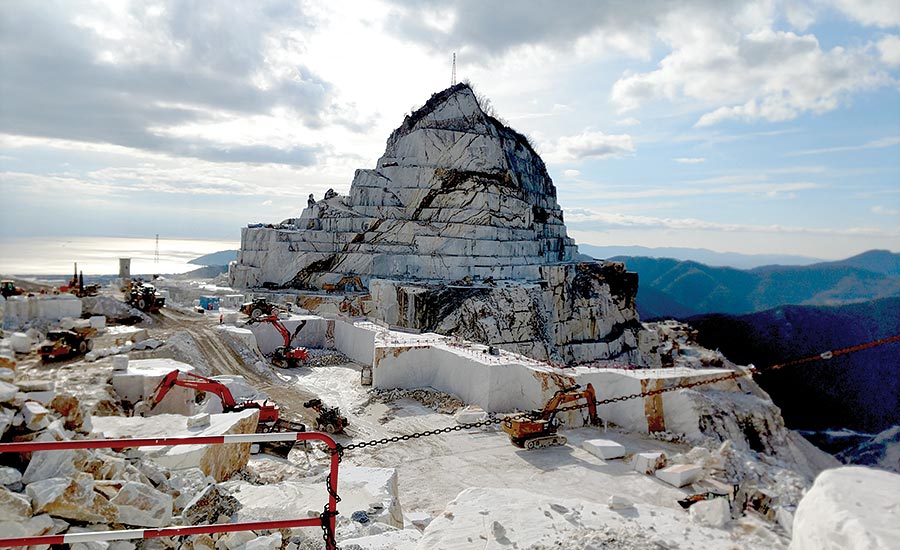
One of the best quotes I personally heard from a fabricator talking to the group about the helicopter experience was, and I won’t mention his name so he doesn’t get in trouble. “My wife asked me what it was like to ride in a helicopter. I told her, ‘Well, there was the day that our child was born. Then there was this helicopter ride.’ She didn’t appreciate the answer that much.”
The second half of the trip
The next day started at Tenax’s facility where Filippo Emanuel gave us a tour — explaining the process of how some of their resins and epoxies were made. “This was the 8th edition of the SFA tour and it was an honor as usual to be able to host them and show them around our ‘house,’” said Emanuel. “The format keeps getting better and we can pack more and more useful information in this relatively short visit. I do believe that this is a fundamental important exchange of information between us and the SFA; the participants bring back ideas to their community and more importantly they give us suggestion, and ideas about their current challenges so we can keep manufacturing solutions for the whole industry. We are proud to have been part of the original idea and we hope this event will keep going and evolve for years to come.”
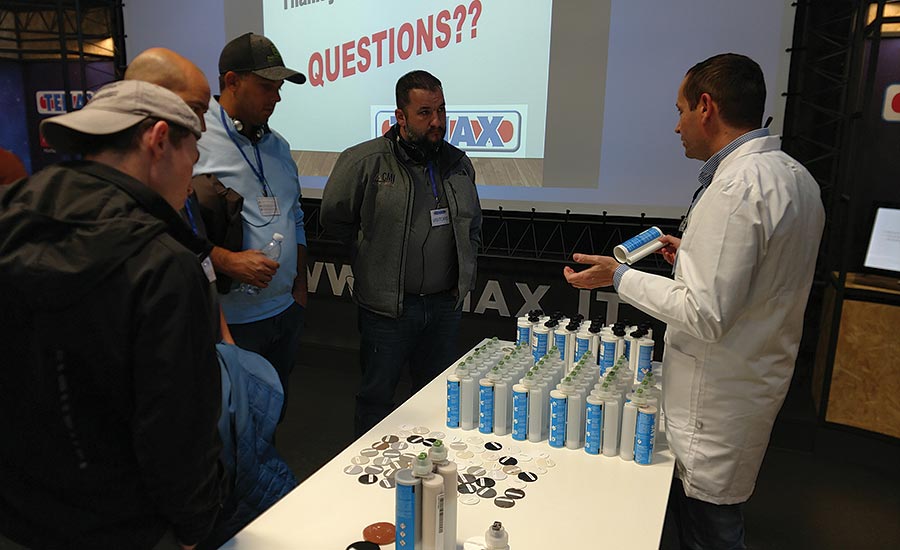
The group first got a tour of the epoxy resin lines to see how the Part A and B epoxies are made, then went onto the abrasives. “We are the only company that is in the business of making everything,” said Emanuel. “From the quarry to the manufacturing to tools and supplies for you guys. We have competitors in all segments, but not all the way through the process like us.” The fabricators were next broken down into groups to learn from scientists and specialists at Tenax, some of these things included glue, glue injectors, abrasives, quartz shields and other resins.
After Tenax, we were on the move again to Donatoni to see how the company’s machines are made. Luca Donatoni toured us around their new facility to show their production ability. “We have the ability to make a machine in three weeks,” said Donatoni. “It is because we stock all the parts here.” Donatoni also discussed their partnership with the Biesse Group that allows them to be more competitive with technical service. “This now allows our technical staff to virtually access the customer’s machine and perform checks, updates as if they were there,” said Donatoni.
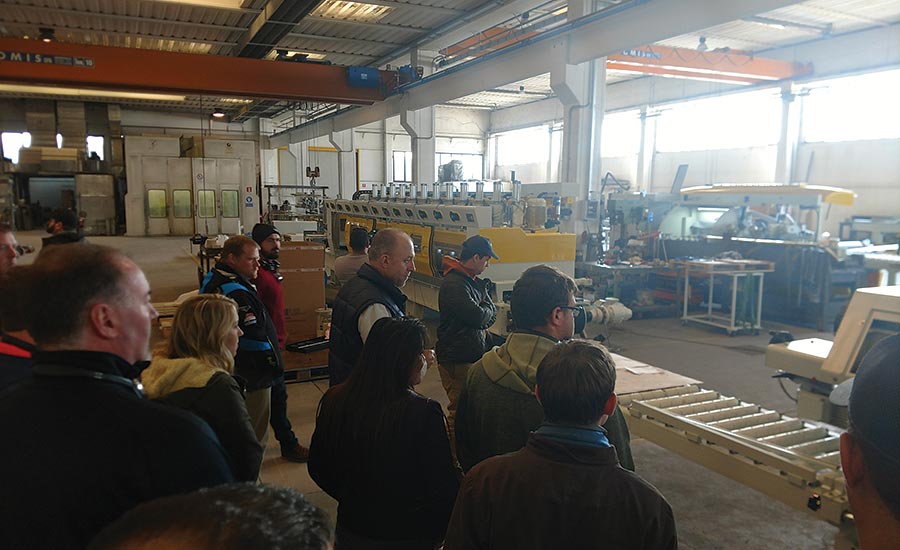
The group then stopped at Citco, to see some of the Donatoni machines in action. The group was able to see different works of art that the fabricator had created using various machines.
The second to last day of the trip started at Santa Margherita where the company showed off its quartz line and then it’s cultured marble line. “We are located here because this has always been a big area for marble,” Michele Caneva of Santa Margherita. “The river to Venice is right over there. So it was easy to be able to process the quarried marble and send it down the river.” During the visit, the company was working on installing another production line. The company also had two polishing lines. They can finish their stones with a polish, honed or brushed. Each of their production lines can make 300 to 350 slabs a day, and each day just one color is produced. Every six hours, the machines have to be cleaned out.
The next stop on the trip I am going to talk about a bit later, but after that stop, we went to Tecnoimpianti where the group got to see different dust collection systems that can be used to help keep their shop OSHA compliant, especially with the new laws that have been taken in effect. They also showed off their water filtration systems that can be custom fit to any shop. Also, for fun, some of the women on the tour tried their hand at using an angle grinder to grind away some granite, and to try out the water curtain dust collection system.
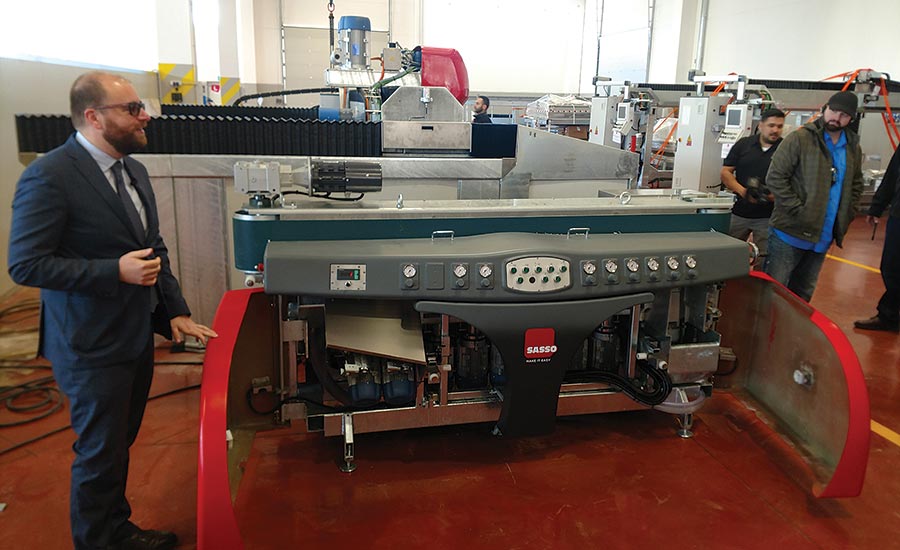
Starting the last day of the trip, the SFA went to visit Margraf where they toured the facility, got to see their production facility and the different materials that are stored there.
Then the group went to GMM where Taf Wharton showed the group polishing lines. “It’s really important for us to show you that our machines are built from the ground up in Italy,” said Wharton. “There are some rumors out there that some Italian companies aren’t building in Italy. As you can see from this trip, which of the companies you have visited, including ours, are truly built in Italy and truly Italian machines.”
The last stop on the trip was to Lapitec, where fabricators got to see how the product was made, the different sizes it came in and how resistant it was to different chemicals and UV light. Michele Ballarin showed the group around and explained that during the recession, the company kept investing in its product so it could become a great product down the road. “The first slab of Lapitec was made in 2011 and in December of 2012 the first slab was sold. In 2013 was when we first opened our market outside of Northern Italy.”
Inspiration for back home
The one part of the trip I left out, as noted above, was a stop to Antolini. It’s amazing how I will mention different places that I have visited over the years to different fabricators around the U.S. and some of them, they have never heard of. Antolini on the other hand is the only name that every fabricator seems to universally know, and with good reason. On this visit, Antolini showed off its Azerocare, a treatment process for natural stone that stops stone from etching, staining and doesn’t react to UV rays. The fabricators were obviously impressed by it. Antolini showed their AVP process where it strengthens the stone to make fragile material more durable. But what I found was the most memorable experience was Antolini’s presentation.
When walking through their gallery, everything was beautifully displayed including natural stone that hung on the walls like art. Also, there would be sections of its building where you walk from one side of the room to the other looking at stone like it was an exhibit, and at the end, you were greeted by a giant set of doors, such as the ones you find in a Chevy commercial, that lead you into the next room where more stone was. This happened quite a few times. “What they are doing at Antolini is what I want to do,” said Figuerra. “[Since coming back from the trip], I painted my warehouse and made it more modern looking. I am just redoing everything. You are selling a luxury product. If you take a minute and look around, you can have all the nice machines, but the customer is also shopping for the experience. We ripped out everything with an ogee edge in the showroom and replaced it with miters. We had to have a conversation with the sales people about how to present ourselves to customers. Our customers are regular people. We just had to figure out how to explain things to our customers and present the product in a way that’s visually important.
“I also added more lighting to my warehouse,” Figurera went on to say. “I am going to try to put up a bookmatched stone on an empty wall. I am going to try as much as I can in a reasonable way to have a presentable facility. Homeowners are going to go to three or four different places, so you have to think what’s going to give them a lasting impression.”
While I may be singling out Antolini in this section, they are not the only company to do it. In general, it was the passion and knowledge the Italians have that makes companies want to change. “Seeing the passion that the folks had for stone was really inspiring,” said Henderson. “From the guys on the factory floors, the quarry workers and even the CEOs, there is so much passion for the stone industry in Italy. It was truly motivating to be inspired everyday while working in this amazing industry.”
For Fung-Donaire, the biggest thing she learned from the trip that has helped improve her business and me as an individual would be from the people she met on the bus. “The connections I have made, I can contact them and have contacted some to help me with improving my advertising or website presence,” said Fung-Donaire. “The Margraf facility was also one place I will never forget. Not that anything I got there will improve my showroom. Just that their fabrication production line was so impressive. Then of course, the tour of Antolini’s showrooms were just jaw dropping. The displays of the slabs and organization of the colors is something I would like to implement in my slab gallery someday.”
Rodriguez was on this trip five years ago, and already knew what to expect. But it was good for him to go back and stand back to watch others experience the trip. Talking to them, they had heard about the trip and what happens, but in his opinion, and he thinks all of them would agree, there is nothing like really being on the trip. “I believe to be a great salesman/business owner, you have to really know your product,” said Rodriguez. “Here in the U.S., we buy processed slabs and give the homeowner/customer information on how slabs are processed or about tooling or sealing, etc. Sitting in these factories and watching the process, I’ve become a more passionate seller. It’s improved me as an individual because I can better explain my product to customers. I think customers can sense I am not making something up to get a sale, but I truly know my craft.”
One of the reasons Rodriguez came back on the trip was to capture it all on video. While I can do my best to explain what happened and the experiences had by fabricators, there is just so much to write about that I could probably fill this magazine with just this story. The worst part of it is, I am never able to remember everything that happened, there is just too much. But if you want to get a quick summary of all the events, check out Rodriguez’s video at Ageless Stoneworks on Youtube: https://youtu.be/a3JMdhMuEVU.




